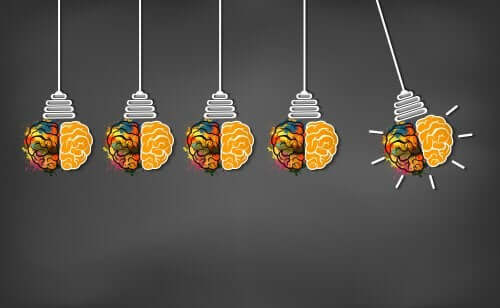Synaptic Pruning During Childhood and Adolescence


Written and verified by the psychologist Elena Sanz Martín
At first sight, childhood and adolescence appear to be two life stages with nothing in common. However, they actually share some important similarities. There’s a good reason why “the terrible twos” are also known as “the first adolescence.” The fact of the matter is that a brain process takes place during this stage of infancy, which is very similar to one that occurs between 12 and 14 years of age. This process is known as synaptic pruning.
The human brain is a complex and fascinating organ that’s in a state of constant change. This is especially true during the first two decades of life. Understanding its functioning can help us put ourselves in the shoes of our children and teens. It helps us accompany them lovingly during these transitions. That’s why, in the following article, you’ll learn all about synaptic pruning and how it affects youth.
What is synaptic pruning?
Synaptic pruning is a process that occurs in the brain that consists of the elimination of neural connections. These connections form based on learning, and when there are too many present, the brain becomes inefficient. Therefore, synaptic pruning gets rid of connections of little use, freeing up brain capacity for more useful and active connections.

In short, it’s a process that remodels the brain. And as a result, the number of existing brain connections decreases and those that remain become stronger. Said regulation gives the brain optimal functioning and, above all, makes it better adapted to its environment.
Synaptic pruning during childhood
From the time an embryo develops until the age of 2, a tremendous amount of neural connections form. These are the fruit of a child making discoveries and obtaining new knowledge. And after this exponential growth, the initial synaptic pruning and restructuring take place.
This is a programmed process that is necessary when it comes to a child’s proper development. However, environment also plays an important role, and it’s here that education can make a huge difference:
- Babies need to receive adequate stimulation in order for this pruning to take place. If not, they’ll maintain an excessive number of connections that will make the brain inefficient. In short, the child will lose capacities.
- The objective of this process is to achieve a better adaptation to the environment. Therefore, influences that come from the exterior will have an impact on which connections remain and which are eliminated. Those that the child utilizes most frequently will get stronger, while those that a child uses less will disappear. Therefore, education will guide this brain remodeling process. The child will keep and strengthen the most developed abilities and areas.
What occurs during adolescence?
In the past, people believed that the brain was completely formed by the time a child reached adolescence. However, experts have since discovered that each region of the brain follows its own course.
Certain areas continue to create new synapsis during puberty. This is true for the prefrontal cortex, which undergoes a great increase in connections between the ages of 11 and 12. This then gives way to a new pruning process.

We need to keep in mind that this region of the brain is responsible for planning, organizing, setting goals, etc… And it doesn’t reach optimal performance until the process is complete, around the age of 20. From this perspective, it’s much easier to understand the difficulties that teenagers have with executive functions.
They’re choosing and discarding information and giving shape to their ability to self-regulate, but it still isn’t fully developed. Therefore, adults need to be understanding of adolescents and offer them guidance and regulation until they can self-regulate on their own.
In the same way, upon completing the second decade of life, the prefrontal cortex will have connected with other brain structures like the amygdala, which is responsible for impulses and emotions. So, individuals gain the ability to self-regulate, and the typical impulsivity of adolescence will diminish.
Guiding the process
In conclusion, synaptic pruning is a natural and necessary brain process. It helps the brain to mature and optimize its functioning. However, understanding when this brain remodeling takes place will help us to understand our children much better.
Most of all, it will help us guide the process through the experiences, learning, and stimuli that we offer toddlers and teenagers.
At first sight, childhood and adolescence appear to be two life stages with nothing in common. However, they actually share some important similarities. There’s a good reason why “the terrible twos” are also known as “the first adolescence.” The fact of the matter is that a brain process takes place during this stage of infancy, which is very similar to one that occurs between 12 and 14 years of age. This process is known as synaptic pruning.
The human brain is a complex and fascinating organ that’s in a state of constant change. This is especially true during the first two decades of life. Understanding its functioning can help us put ourselves in the shoes of our children and teens. It helps us accompany them lovingly during these transitions. That’s why, in the following article, you’ll learn all about synaptic pruning and how it affects youth.
What is synaptic pruning?
Synaptic pruning is a process that occurs in the brain that consists of the elimination of neural connections. These connections form based on learning, and when there are too many present, the brain becomes inefficient. Therefore, synaptic pruning gets rid of connections of little use, freeing up brain capacity for more useful and active connections.

In short, it’s a process that remodels the brain. And as a result, the number of existing brain connections decreases and those that remain become stronger. Said regulation gives the brain optimal functioning and, above all, makes it better adapted to its environment.
Synaptic pruning during childhood
From the time an embryo develops until the age of 2, a tremendous amount of neural connections form. These are the fruit of a child making discoveries and obtaining new knowledge. And after this exponential growth, the initial synaptic pruning and restructuring take place.
This is a programmed process that is necessary when it comes to a child’s proper development. However, environment also plays an important role, and it’s here that education can make a huge difference:
- Babies need to receive adequate stimulation in order for this pruning to take place. If not, they’ll maintain an excessive number of connections that will make the brain inefficient. In short, the child will lose capacities.
- The objective of this process is to achieve a better adaptation to the environment. Therefore, influences that come from the exterior will have an impact on which connections remain and which are eliminated. Those that the child utilizes most frequently will get stronger, while those that a child uses less will disappear. Therefore, education will guide this brain remodeling process. The child will keep and strengthen the most developed abilities and areas.
What occurs during adolescence?
In the past, people believed that the brain was completely formed by the time a child reached adolescence. However, experts have since discovered that each region of the brain follows its own course.
Certain areas continue to create new synapsis during puberty. This is true for the prefrontal cortex, which undergoes a great increase in connections between the ages of 11 and 12. This then gives way to a new pruning process.

We need to keep in mind that this region of the brain is responsible for planning, organizing, setting goals, etc… And it doesn’t reach optimal performance until the process is complete, around the age of 20. From this perspective, it’s much easier to understand the difficulties that teenagers have with executive functions.
They’re choosing and discarding information and giving shape to their ability to self-regulate, but it still isn’t fully developed. Therefore, adults need to be understanding of adolescents and offer them guidance and regulation until they can self-regulate on their own.
In the same way, upon completing the second decade of life, the prefrontal cortex will have connected with other brain structures like the amygdala, which is responsible for impulses and emotions. So, individuals gain the ability to self-regulate, and the typical impulsivity of adolescence will diminish.
Guiding the process
In conclusion, synaptic pruning is a natural and necessary brain process. It helps the brain to mature and optimize its functioning. However, understanding when this brain remodeling takes place will help us to understand our children much better.
Most of all, it will help us guide the process through the experiences, learning, and stimuli that we offer toddlers and teenagers.
All cited sources were thoroughly reviewed by our team to ensure their quality, reliability, currency, and validity. The bibliography of this article was considered reliable and of academic or scientific accuracy.
- Cáceres, C. B. (2017). La neurociencia en la primera infancia. Apuntes de Ciencia & Sociedad, 7(1).
- Triskier, F. J. (2006). Algunas especulaciones respecto a las modificaciones neurobiológicas durante la adolescencia. EL RESCATE Y LA MEMORIA, 17(70), 424.
This text is provided for informational purposes only and does not replace consultation with a professional. If in doubt, consult your specialist.








